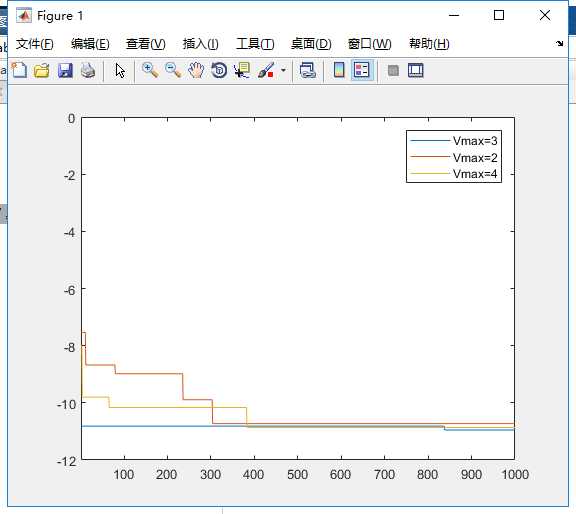概念不复述了,网上都有,这里讨论标准PSO
w = 0.9; c1 = 2; c2 = 2; Vmax = 3;
种群大小 M = 20;迭代次数 N = 1000
1 function res=PSO(N,M,w,c1,c2,Vmax) 2 %w = 0.9; c1 = 2; c2 = 2; Vmax = 2; 3 %P(:,1:2) = 200*rand(M,2)-100; 4 P(:,1:2) = 3*rand(M,2); 5 P(:,3:4) = 2*Vmax*rand(M,2)-Vmax; 6 [g,pbest]= pb(P); 7 j = 0; 8 res = []; 9 tic 10 while j < N 11 for i=1:M % exchange message between each other 12 if(fitness(P(i,1),P(i,2)) < fitness(pbest(i,2),pbest(i,3))) 13 pbest(i,2:3) = P(i,1:2); 14 pbest(i,1) = fitness(P(i,1),P(i,2)); 15 end 16 g = pbest(i,:); % update g by Piself 17 g = betterNei(pbest,i,g); % update g vs neighbour 18 19 % update position and speed of Pi % update Px 20 P(i,3:4) = w*P(i,3:4)+c1*rand*(pbest(i,1:2)-P(i,1:2)) ... 21 + c2*rand*(g(2:3)-P(i,1:2)); 22 P(i,3:4) = P2Vmax(P(i,3:4),Vmax); % update Pv 23 P(i,1:2) = P(i,1:2) + P(i,3:4); 24 end 25 j = j + 1; 26 res(j) = g(1); 27 end 28 time = toc; 29 result(g,time); 30 end
Fitness
function f=fitness(x1,x2) f = 2*x1.^2-4*x1.*x2+4*x2.^2-6*x1-3*x2.... +1000*(max(x1+x2-3,0))+1000*(max(4*x1+x2-9,0));%1000 可以换成任意非常大数
P2Max
1 function P = P2Vmax(P,Vmax) 2 % > Vmax 3 P(P > Vmax) = Vmax; 4 % < -Vmax 5 P(P < -Vmax) = -Vmax; 6 end
pb
1 function [g,pbes]=pb(P) 2 pbes(:,1) = fitness(P(:,1),P(:,2)); 3 pbes(:,2:3) = P(:,1:2); 4 [~,temp1] = min(pbes);%找出列向量最小的位置 5 temp1 = min(temp1);%最小中的最小 6 g(1) = pbes(temp1); 7 g(2:3) = P(temp1,1:2); 8 end
result
function result(g,time) fprintf(‘ x1: %10.12f\n‘,g(2)); fprintf(‘ x2: %10.12f\n‘,g(3)); fprintf(‘f(x1,x2): %10.12f\n‘,g(1)); fprintf(‘ time: %10.12f s\n‘,time); end
Better_Nei
% 在邻居中寻找更好的点代替 function g = betterNei(pbes,i,g) M = size(pbes,1); pbe(1:i-1,:) = pbes(1:i-1,2:3); % i的附近 pbe(i:M-1,:) = pbes(i+1:M,2:3); temp0 = fitness(pbe(:,1),pbe(:,2)); [~,temp] = min(temp0); temp = min(temp); g(1) = temp0(temp); g(2:3) = pbe(temp,:); end
可视化
res1 = PSO(1000,20,0.9,2,2,3); res2 = PSO(1000,20,0.9,2,2,2); res3 = PSO(1000,20,0.9,2,2,4); plot(1:1000,res1,1:1000,res2,1:1000,res3) axis([1,1000,-12,0]) legend(‘Vmax=3‘,‘Vmax=2‘,‘Vmax=4‘,‘Location‘,‘NorthEast‘)
结果:

完.hahaha
原文:https://www.cnblogs.com/zero27315/p/10547054.html